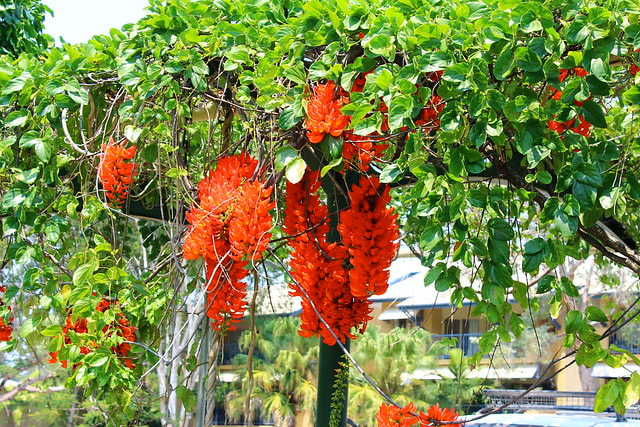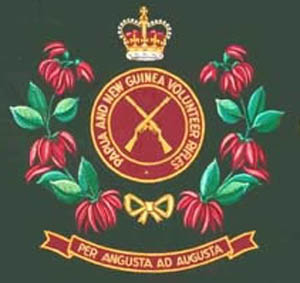The Regimental flower
Regimental Colours: A conventionalised rendition of the flowers and leaves is shown as a wreath wrapped round the Regiment’s badge on the Regiment’s Colours, the only Australian unit which has incorporated a flower this way, the only other flower used by Australian units has been the wattle. The “Flame of the Forest” was selected because of its uniqueness to Papua New Guinea and reflected the uniqueness of NGVR and PNGVR. Phil Ainsworth was responsible for the selection of this flower and the initial design for the Colours, on or about 1966.
Common names: “Flame of the Forest” or “D’Albertis Creeper” or “New Guinea Creeper”
Botanical name: Mucuna nova-guineansis
Family: Leguminosae
Origin: Papua New Guinea
Flowers: Inflorescence of crimson crescent-shaped flowers which may grow to 8.5 cm, usually around October.
Foliage: Trifoliate leaves composed of dark green, elliptic leaflets from 11 to 14 cm long fully grown
Height: This climber will grow into a 15m vine
Seed: A large round (40mm diameter x 10mm deep) flat bean like seed counting roughly 115 per kg
Fragrance: No
Poisonous Part: None
Discovery: By Luigi D’Albertis (1841-1901) , an Italian naturalist on his 1875 (second) visit to Papua to explore the Fly River to collect plants, insects, reptiles, mammals, especially birds of paradise and native artefacts.
Common names: “Flame of the Forest” or “D’Albertis Creeper” or “New Guinea Creeper”
Botanical name: Mucuna nova-guineansis
Family: Leguminosae
Origin: Papua New Guinea
Flowers: Inflorescence of crimson crescent-shaped flowers which may grow to 8.5 cm, usually around October.
Foliage: Trifoliate leaves composed of dark green, elliptic leaflets from 11 to 14 cm long fully grown
Height: This climber will grow into a 15m vine
Seed: A large round (40mm diameter x 10mm deep) flat bean like seed counting roughly 115 per kg
Fragrance: No
Poisonous Part: None
Discovery: By Luigi D’Albertis (1841-1901) , an Italian naturalist on his 1875 (second) visit to Papua to explore the Fly River to collect plants, insects, reptiles, mammals, especially birds of paradise and native artefacts.


